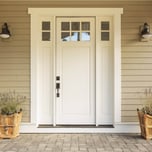Answer these simple questions and we will find you the BEST prices
Which type of solar quotes do you need?
It only takes 30 seconds
100% free with no obligation



- GreenMatch
- Blog
- How to Clean Windows
How to Clean Windows: Inside & Outside Your House

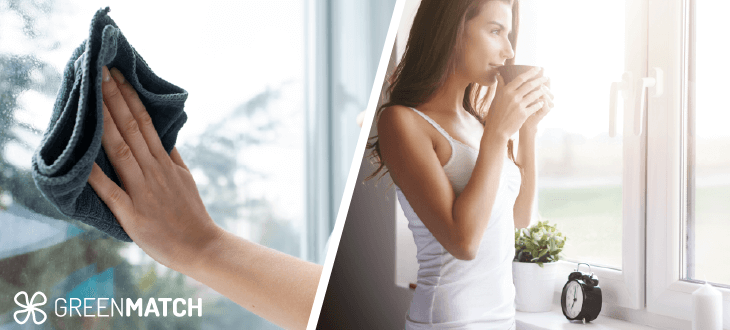
Are you looking for the best way to clean windows? We've got the perfect solution for you! We've gathered all the necessary tricks and tips from window experts, double glazing companies, professional cleaners, and homeowners to give you the best advice to make your windows sparkle.
We’ve outlined each step, with tips on methods and the best cleaning solutions, so you can quickly learn the do’s and don’ts! Our guide will also help you achieve amazing results for your inside and outside windows. Read on to discover the best way to clean windows.
What is the best way to clean your windows?
Step 1: Prepare for cleaning
The first step to consider is the weather. It might not seem important if you are cleaning inside windows, but almost every expert we spoke to recommends that you do not clean windows on hot, sunny days or when the sun shines directly on the glass.
Cleaning expert John Larson from Best Cleaning Tools told us:
Choose a cloudy day or early morning or late evening to clean your windows, as direct sunlight can cause the cleaning solution to dry too quickly and leave streaks.
Step 2: Gather the right tools
There are some basic tools you will need for the job, including:
- A duster or vacuum
- Microfibre cloths
- Cleaning products (a spray or bucket of soapy water)
- Squeegee
Never use hot water on your windows! Aside from being a burn risk, it can also damage your window sealant, or get into small cracks and make them bigger!
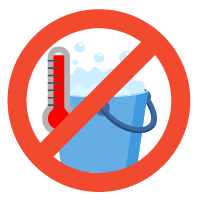
There are many products and tools you can use, but what is best for cleaning windows in your home will depend on your preference. For example, shop-bought window cleaning sprays are the easiest option, and great for all UPVC window styles. However, if you’re more environmentally conscious, you might want to mix your own cleaning solution to avoid single-use plastics. (We have some ideas for this later in the guide!)
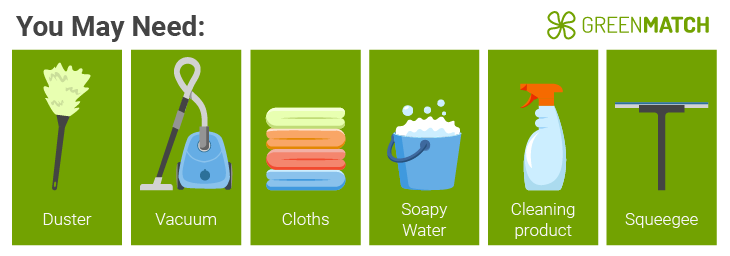
Step 3: Inspect your windows
Now we’re ready to clean, it’s important to take a few minutes to check the health of your windows. You will need to remove any curtains or blinds to get good access, but here are some things to look out for:
- Check for damage/cracks in window sealant and surrounds
- Look for cracks or problems with the glass
- Look around the sills and frames for any mould, or signs of condensation
Signs of damage to your window panes, or the surrounding seal can be a cause for concern. If you have double or triple glazing the sealant is crucial in preventing air and moisture from getting between the glass panes.
Also, if there are any cracks or gaps in the glass, the space between the panes will be exposed. Not only can this reduce the window's insulation capabilities, but it can cause condensation to form or give a foggy appearance to your glass.
If you notice any damage to your windows, you should consider the best window replacement options for your home. New windows can be beneficial, from added heat retention to energy and cost savings. You should also take extra caution not to clean, or use harsh products, on damaged windows as it can make the problems worse.
Step 4: Time to clean
First, grab a duster and wipe away any dust or debris from around the windows and the sills (this will help you avoid rubbing any abrasive grit across your glass).
Next, clean your surrounds and sealant with some warm soapy water. Avoid using harsh chemicals in these areas as this can damage your sealant. Mould is often an issue in these areas, so if you spot any you can wash it off and follow up with an antibacterial solution to maintain a clean and healthy atmosphere.
If you find significant damage to your sealant, you should get this repaired by qualified UPVC window installers, to ensure optimal performance and avoid any insulation or further mould problems.
Now on to the glass! Our cleaning experts recommend starting from the top of the window and working your way down for maximum efficiency.
Michelle from Live Another Day reports that:
This will prevent streaks from running down the window and will make it easier to see if there are any spots or streaks that need to be re-cleaned.
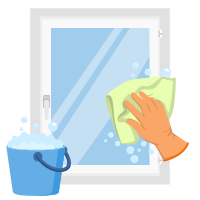
You can apply your cleaning solution directly onto the window or you can use a cloth - whatever works best for you! Focus on one area at a time and work your way down the window.
If you want to know how to clean windows without streaks, the key is to clean in a circular motion and take your time. After cleaning, you may want to rinse off any product or use a new microfibre cloth to buff up the glass and ensure all solution has been lifted away.
Step 5: Let it dry out and enjoy!
To dry your windows, you can use a rubber squeegee to remove any excess water. Simply pull the squeegee from top to bottom, and wipe it dry in between each wipe. You can also open up windows to let air circulate and help them dry faster.
Now you can then sit back and enjoy a streak-free shine!
Noticing window streaks? Simply grab a microfibre cloth and, in circular motions, polish up the streaky areas - this should do the trick!
What to use to clean windows?
Finding the best thing to clean windows with can seem overwhelming, with various products in stores and concerns about eco-friendly packaging. Our experts have helped with this issue, by giving us the low-down on the best, and easiest, things to clean windows with.

Microfibre cloths
Every expert recommends these cloths because they can quickly and effectively remove dirt, absorb moisture and produce a shine on surfaces. Plus, they won’t deposit any fibres or fluff on glass.
Squeegee
Cloth-head squeegees offer a quick way to clean large areas, particularly if you have one with an extendable pole. Rubber squeegees are also the hero for removing water and leaving glass streak-free!
Cleaning solution
Your cleaning solution will depend on what cleans windows best for you.
Hugo Guerrero, a Certified House Cleaning Technician from Mattressive, gave us this top tip:
Many commercial window cleaning solutions are available, or you can make your own using a mixture of water and white vinegar or dish soap. Avoid harsh chemicals or ammonia-based cleaners, as they can damage the glass.
Regular water and dish soap make a gentle, soapy wash for windows that can do an excellent job! Some other homemade cleaning formulas, however, are great for different kinds of window cleaning.
Extra dirty or outdoor windows?
If you need to know how to clean window stains and a simple solution isn't cutting it, you could try using baking soda. This slightly abrasive powder can easily lift tough grime but is gentle enough not to damage surfaces. Use this by sprinkling some onto a damp cloth and using small, circular motions to clean the toughest dirt from your window.
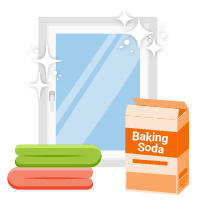
What is the best homemade window cleaning solution?
If you’re cleaning greasy or grimy windows, try using white vinegar. This is commonly found in window cleaning sprays because it’s great at cutting through grease but also minimises streaks.
If you’re wondering how to clean windows with vinegar at home, you can dilute it in water ready for cleaning. Simply mix two parts of water with one white vinegar (2:1).
Live in a hard water area?
Using distilled water instead of tap water can make a big difference. Using hard tap water can leave behind spots or mineral deposits on the glass, but distilled water doesn’t have this problem.
Things to avoid!
Certain cleaning ingredients that are usually great around the home, are not great for windows!
-
Lemon juice or essential oils:
These can leave marks and streaks behind and will be difficult to wash off. -
Ammonia or alcohol:
Many experts suggest avoiding solutions containing these chemicals. Mainly because they can break down the sealant, causing it to become brittle and crack. They can also leave stains or marks on glass if they need to be correctly diluted. -
Always test first:
Avoid spraying any new product ALL over your windows. Test on a small area first to prevent damage from occurring.
If you’re unsure of the best solution for cleaning windows, using a mild option such as dish soap and water is safest. You can find lots of ready-made glass cleaning products available to buy, but just be sure to check the label and user directions carefully before use.
How to clean windows outside?
The best way to clean outside windows is essentially the same as we use indoors, but we need to account for two other major factors - the weather and heights! Here are some easy steps on how to clean windows outside of your home.
Step 1: Assess your cleaning needs and abilities
Before tackling outdoor window cleaning, you must assess which windows need cleaning, if you can reach them and if you feel safe and comfortable to do so. If you don’t have the right equipment or support to work at heights, it’s always safer to hire a trained professional to tackle the job for you.
In addition, it’s highly important that you only clean high outdoor windows when the weather is calm and dry. This will help you avoid accidents.
Step 2: Gather your equipment
You will need the cleaning essentials, plus some items to help you reach those higher windows. This can include:
- A bucket (for soapy water) or to hold your cleaning products
- Some cloths (for washing and buffing)
- A squeegee (for washing or removing water)
- Extendable pole (if you can’t effectively reach the whole window)
- A sturdy ladder
- Another person!
If you are using a ladder to reach upper-floor windows, make sure someone is nearby to help you in case of an accident.
Step 3: Pre-soak your windows
Giving your windows a pre-wash with a garden hose can make the job of cleaning outside windows a little bit easier. This will remove initial dirt and can often be quite effective even from ground level.
Next, prepare or make up your cleaning solution. Water and dish soap is a good outside window cleaner, but if you have particularly dirty windows you might want to add some white vinegar to your solution.

Step 4: Clean the top windows first
It’s recommended that you start with the windows at the top of your home first, this helps to prevent any dirty water from getting onto clean windows below.
If you’re using a ladder, take care to ensure you use it as per the manufacturer's instructions and have somebody nearby to help you.
For easy access to your washing tools, use a bucket that you can hook onto your ladder, or a tool belt (if you’re using cloths). Once you're comfortable and safe, you can begin to clean your outside windows just as you would inside.
Remember these key points:
- Clean dirt from surrounds and window sills first.
- Apply your cleaning solution and use circular motions to scrub away stubborn dirt.
- Rinse your sponge or cloth regularly to avoid moving dirt around.
- Use a hose if you have one, to rinse any cleaning solution from the windows and surrounds after cleaning.
If you are using a homemade solution, use one bucket for cleaning solution, and the other to rinse your sponge or cloth. This can make cleaning much more efficient.
Step 5: Dry the windows
To avoid a streaky finish, make sure to use a dry cloth or rubber squeegee to remove all excess water from your window. You can then let it dry naturally (providing you’ve chosen the right weather!).
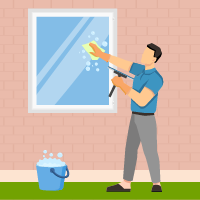
Once you’re happy the upper windows are clean, you can move on to the lower levels. This will require the same steps again, but you should account for any obstacles (such as plants or trees) and take care to navigate safely around them.
If you see any streaks forming after the windows are dry, remember to use a clean, dry microfibre cloth to buff the surfaces for a gleaming finish.
How to clean windows inside?
Cleaning your windows is not only a great way to improve visibility, but it also has added benefits, including:
- Improving your air quality by removing dust and pollutants.
- Prevents mould buildup and regrowth.
- Extends the life of your windows, by removing the buildup of debris that can cause damage.
- Increase natural light flow to improve indoor temperature (and boost mood!).
With this in mind let's take a look at the best way to clean windows inside your home so that you can make the most of these benefits.
Step 1: Be prepared
Start by removing any surrounding items, such as blinds or net curtains (these should be cleaned separately).
Next, inspect the windows for any potential problems. Look for damage to the window sealant, mould build-up or grimy window tracks. Any damage will need special attention and should not be cleaned with harsh chemicals or hot water, as it can cause further problems.
Step 2: Get the right tools
Next, you’ll need to decide on the best thing for cleaning windows in your property. You can find simple window cleaning sprays in most supermarkets or you can make your own. A solution of water and white vinegar is great for extra cleaning power, but dish soap and water are just as good.
Remember, no matter what you clean windows with, never use hot or boiler water. This is a major burn risk, and can also cause serious damage to your windows.
You will also need good microfibre cloths or a large, soft sponge. It’s important to use gentle cleaning tools to avoid scratching your glass. You may also want to use a squeegee to remove excess water.
Step 3: Clean the surrounds
Before starting on the windows, carefully clean the surrounding areas. This includes the sills, sealant and any opening window tracks. Avoid using harsh chemicals here! Soapy water is perfect for these areas, but you might need to use a small brush to get into the tracks.
Step 4: On to the windows!
Using your cloth, or sponge, start from the top of the window and work your way down. Using small circular motions, apply your cleaning solution (either a spray on the glass, or onto the cloth) and begin lightly scrubbing.
Continue across and down the enter pane, until you’re happy all the dirt has been removed. If you’re cleaning very dirty glass, you may need to go back over the window again with a clean sponge/cloth and clean water to rinse off the dirt and any cleaning product that’s been left behind (do this as many times as required).

Step 5: Dry/buff the glass
If you’ve used soapy water, you might wish to use a squeegee next to remove any excess water. A rubber squeegee can be a great tool for this job - simply run it down the window, from top to bottom, to push water away from the glass.
Be sure to dry the squeegee after each swipe, and carry on along the length of the window until it’s dry.
Next, take a dry microfibre cloth and mop up any remaining water, particularly around the edges of the window. This is also a good time to open any windows and let air in to aid with the drying process.
Step 6: Noticing steaks or smears?
Don’t worry! These can be fixed quickly by taking a clean, dry microfibre cloth and polishing up the area with small circular motions. This should remove the streaks in no time.
Streaks and smears often happen if too much product is left on the window (such as soap or sprays), so the best way to avoid this is to make sure you don’t overuse your cleaning solution and give everything a thorough rinse and wipe down.
Frequently asked questions
A solution of water and white vinegar (2:1), applied with a microfibre cloth is the best way to clean windows. You can find commercial products with these ingredients, or easily make the solution yourself at home. Dish soap and water is a great alternative if you prefer.
Using a microfibre cloth and solutions which contain white vinegar, is a great way to avoid streaks when cleaning windows inside or out! If streaks do occur, a dry microfibre cloth can buff and polish a window back to a shine.
The most common professional window cleaning solution is a simple mixture of distilled or filtered water and dish soap. They use a squeegee or scrubber tool and simple microfiber cloths.
Streaks and smears are usually caused by too much product being left on the window, or use of the incorrect product. To avoid smears thoroughly dry after cleaning windows outside or use a microfibre cloth to polish the window once clean.
No, white vinegar is one of the best things to clean windows with (when diluted). It cuts through dirt and does not leave smears. Streaks happen when windows are not correctly dried or cleaning solution is left behind.

Becky is an experienced SEO content writer specialising in sustainability and renewable trends. Her background in broadcast journalism inspires reliable content to help readers live more sustainably every day.
We strive to connect our customers with the right product and supplier. Would you like to be part of GreenMatch?


